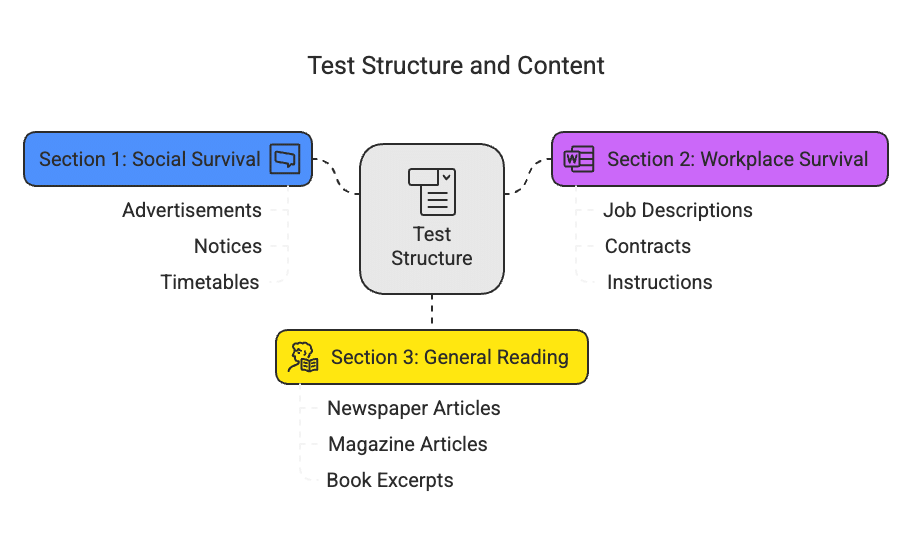Top FAQs: IELTS General Reading Test | Reading for General Training IELTS PDF Download
The IELTS General Training Reading Test evaluates your ability to understand everyday written English. It's different in content from the Academic Reading test and is designed for candidates applying for work, training programs, or migration. Below are the most frequently asked questions to help you prepare effectively.
1. What is the format of the IELTS General Reading Test?
The test consists of three sections with a total of 40 questions. The texts become more challenging as the test progresses.
Section 1: Social survival – Short texts such as advertisements, notices, or timetables.
Section 2: Workplace survival – Texts related to job descriptions, contracts, or instructions.
Section 3: General reading – A longer passage from a newspaper, magazine, or book.

2. How long is the General Reading Test?
You are given 60 minutes to complete the entire test. There is no additional time to transfer answers in the paper-based test, so you must manage your time wisely.
3. How is the General Reading test different from the Academic Reading test?
The question types are similar, but the text difficulty is different:
General Training features more everyday and workplace-related content.
Academic includes more complex, scholarly texts.
The scoring may also differ slightly, with General Training requiring more correct answers for higher bands.
4. What types of questions are asked in the General Reading test?
Some common question types include:
Multiple choice
Matching headings
True/False/Not Given
Matching information or features
Sentence and summary completion
Short-answer questions
Identifying the writer’s views or claims
5. How is the Reading test scored?
You receive 1 point for each correct answer out of 40. The raw score is then converted to a band score (0–9).
Approximate Band Score Conversion (General Reading):
30 correct answers ≈ Band 6
34 correct answers ≈ Band 7
38–40 correct answers ≈ Band 8+
6. Are spelling and grammar important?
Yes. Incorrect spelling or using the wrong word form (e.g., plural vs. singular) will result in a wrong answer, even if the meaning is correct.
7. Do the answers follow the order of the text?
In most cases, yes. For questions like True/False/Not Given or sentence completion, the answers usually follow the order of the passage. However, for Matching Headings and Matching Features, the answers may come in any order.
8. Should I read the entire passage first?
No need to read every word. Instead, skim the passage for the general meaning, then read the questions, and scan for specific details. This helps you manage time better.
9. Can I write on the question paper during the test?
Yes, if you're taking the paper-based test, you can underline, circle, or make notes. However, only answers written on the answer sheet will be marked. In the computer-delivered test, you can use highlighting and notes on screen.
10. How can I improve my General Reading score?
Practice regularly with General Reading materials
Work on skimming and scanning skills
Learn how to identify keywords and paraphrasing
Time yourself during practice to simulate test conditions
Review your mistakes to understand common traps
11. Do I need to have knowledge of the topic to answer the questions?
No. The test is designed to assess your reading and comprehension skills, not your background knowledge. All the answers are based only on the text provided, so you don’t need any prior knowledge about the topic.
12. Can I answer questions in any order?
Yes, you can answer the questions in any order during the test. However, it’s often more efficient to go section by section, as most answers appear in order within each passage. Skipping around too much might waste time.
13. What’s the best way to manage time during the test?
You have 60 minutes for 3 sections and 40 questions. A suggested approach is:
Section 1: 15 minutes
Section 2: 20 minutes
Section 3: 25 minutes
Always keep a close eye on the clock and move on if you get stuck—guessing is better than leaving answers blank.
14. Is there negative marking for incorrect answers?
No. There is no penalty for wrong answers, so you should attempt every question, even if you're unsure. Eliminate obviously wrong options and make your best guess.
15. Can I use capital letters in my answers?
Yes, you can write your answers in ALL CAPITAL LETTERS, especially in the paper-based test. This can reduce the risk of handwriting being misread or marked incorrect due to unclear letters.
|
25 videos|61 docs
|





















